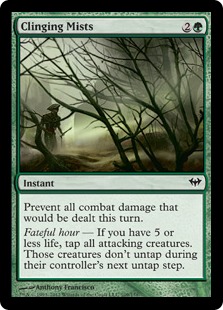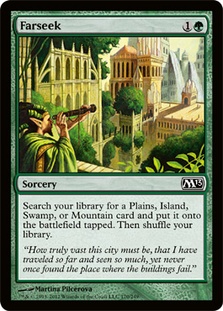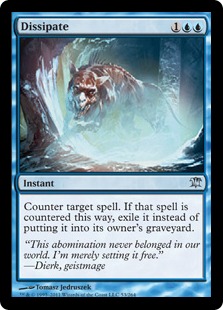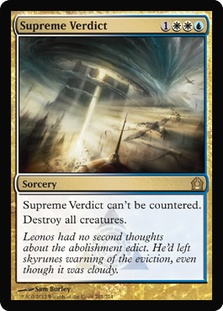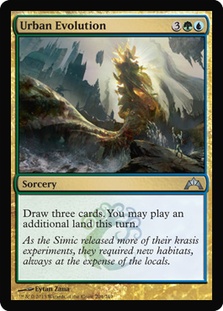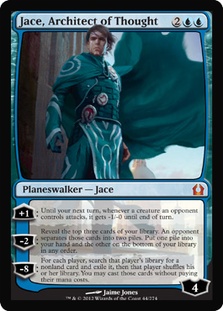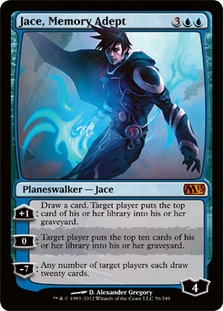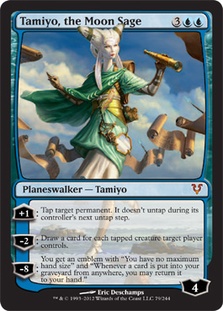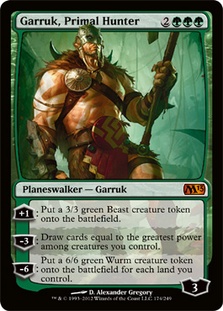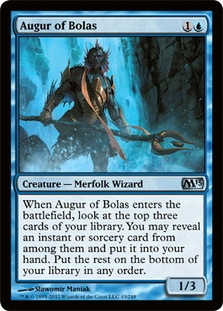It’s no secret that Reanimator has been dominating Standard. Just take a look at this Top 8 of a recent SCG Invitational Qualifier.
Craterhoof Behemoth has been ending a lot of games prematurely. What looks to be a clogged board state is suddenly a bloodbath upon his arrival. So much death. What can men do against such reckless hate? Ride out and FOG THEM. That’s right. Fog them.
This deck was created after I’d spent a couple weeks trying to find an Esper build that I liked. Any stumbles from the deck were nearly impossible to recover from, though, as Reanimator can just Acidic Slime you out of the game while Naya outright kills you. Brandon Scheel and I had been discussing Esper builds for quite some time—until one night Scheel mentioned trying out a big Fog deck. We figured that if we could prolong the game while gaining advantage through planeswalkers, eventually the walkers would take over and win. I pieced together a Fog deck to torment tournament practice rooms with, expecting nothing more than a couple laughs before going to bed.
After winning a few casual games, I decided to throw away some tickets in two-man queues. The funny thing is that I kept winning. I jumped into a couple eight-man queues and continued to Fog my way to victory against Naya Blitz, R/G Aggro, and, most importantly, Reanimator. I sent the list to Scheel for input and then posted it in the Standard discussion group I have with my friends and fellow Iowa grinders. We spent the next few days tweaking and tuning the deck by playing mostly in Daily Events and eight-man queues. Scheel streamed with the deck a bit on Wednesday, and by Friday we had a solid list to register for the Magic Online Pro Tour Qualifier:
Creatures (5)
Planeswalkers (7)
Lands (25)
Spells (23)
- 1 Dissipate
- 4 Fog
- 4 Farseek
- 4 Clinging Mists
- 1 Terminus
- 4 Supreme Verdict
- 3 Sphinx's Revelation
- 2 Urban Evolution
Sideboard

Going into the tournament, I had a record of 30-8 with the deck, so I felt pretty good about my chances. Scheel was unable to PTQ, but a few of my other friends had decided to pilot it as well. Unfortunately, we had not played against nearly enough blue decks. The initial thought was that we would be able to win through our card advantage and planeswalkers, but that simply wasn’t the case. Esper has just as much card draw (if not a little more) and enough countermagic to keep our threats from ever hitting the board.
I ended up 6-3, beating everything that didn’t have Sphinx’s Revelation. However, it came to my attention that a few people outside of my playtesting group had taken note of the deck and were giving it a try. Todd Anderson made some drastic changes (most of which I don’t care for, unfortunately) and lost playing for Top 8, while BReal2 made it to the finals, losing to U/W/R after mulliganing to four in game 1 and mulliganing to six in game 2 in what is already a tricky matchup. You can find their lists here and here.
I decided to try Think Twice for the Premier Event on Saturday at the request of my friend Adam. We were hoping that it coupled with two maindeck Dissipates and an adjusted sideboard would help give us a boost in the control matchups. After missing Top 8 due to a little bit of rough luck and a couple misplays, I decided to register the same list for the Sunday PTQ. This is what I played on Sunday (once again to a 6-3 result):
Creatures (4)
Planeswalkers (7)
Lands (25)
Spells (24)
Sideboard

This time, my losses were much more under my control, which was very frustrating. I just have to make sure I don’t make the same mistakes again in the future. Think Twice underperformed. While it is good in Esper and U/W/R, those decks are both executing very different game plans than Turbo Fog. Think Twice grants small advantages over time, but we want to go big or go home. Moving forward, I would recommend starting with the following list:
Creatures (5)
Planeswalkers (7)
Lands (25)
Spells (23)
Sideboard

Card Choices
Ahh, yes. The cornerstone of the deck. Fog protects both your planeswalkers and your life total. In most situations, it is best to use Clinging Mists before Fog so that you can afford to play a Planeswalker and protect it with the investment of a single mana.
While usually worse than Fog, Clinging Mists is what makes the Reanimator matchup so ridiculously good for you. With Obzedat, Ghost Council and Deathrite Shaman as their only ways of dealing direct damage to you, it is usually safe to allow yourself to fall to five life just for the sake of fateful hour turning this Time Walk into Time Stretch.
It should also be noted that you can be tricky with first strike creatures from your opponent’s side. In one of my matches in the Premier Event, I allowed Thalia to knock me from seven to five and then cast Clinging Mists to lock down my opponent’s entire board. He had already tapped out to play a couple haste creatures, which allowed me to cast Tamiyo and -2 her to draw six cards two turns in a row. I won that game.
Farseek is what allows the deck to play so many five-mana spells and still maintain its functionality. I really wish it was Explore, but I certainly won’t complain.
While it isn’t 100% necessary for most matchups, it is very important if you want to have a chance against the other blue decks in the format.
This card is usually worse than Fog in several matchups since it costs four mana, leaves behind Thragtusk Beasts, and can leave you vulnerable to haste creatures. Alchemist’s Refuge helps with all of those issues, while Garruk can also do a fair amount of work.
Urban Evolution is yet another source of card draw. The additional land drop comes in handy if you want to leave up Fog while also helping you accelerate to larger Sphinx’s Revelations. It is fairly miserable against the aggressive decks, but its power against midrange strategies and control make it a worthwhile inclusion.
It is rare to see a blue deck that isn’t casting this, and you would be a fool to consider cutting it. The life points granted allow you to stay out of burn range, although it is somewhat clumsy with the fateful hour portion of Clinging Mists.
I was initially skeptical of Jace, as his ultimate is fairly grindy while his Weakstone ability is generally not good enough in a format full of Thragtusks and Loxodon Smiters. I saw his -2 as a solid source of card advantage, but the engine he offers is certainly the best you can do for four mana. He is what puts your Farseek draws over the top. I’ll likely be playing at least two of them from now on.
Big Jace is your win condition for the attrition matchups. He gets sideboarded out for the aggro games, but I like to have a second in the sideboard to ensure he arrives in time to defeat the other blue decks.
Where would a Fog deck be without Tamiyo? All of her abilities are fantastic in this deck. Her +1 forces your opponents to play into Supreme Verdict, her -2 is often double Tidings (or better!), and her ultimate allows you to Fog lock your opponents out of the game! She is at her weakest against control, but she can at least keep one Nephalia Drownyard under control.
Garruk is very weak against Esper but is probably your best planeswalker against the aggro decks. He forces your opponents to commit more creatures to the board, provides protection from haste creatures post-Supreme Verdict, can contribute to the card drawing engine, and his ultimate ends the game against any deck not sporting Supreme Verdicts of its own.
Augur has fluctuated between a two- and three-of in my testing. It’s very important for the aggressive matchups but is rarely more than a cycled Renewed Faith.
Snapcaster has been swapping back and forth with Augur as a two- or three-of. He does everything he’s always done but can sometimes clog up your hand. Some opponents will board in Rest in Peace against you, so minimizing their usefulness by sideboarding Tiago out is perfectly reasonable.
Exclusions
I have tried the following cards but haven’t cared for any of them:
Think Twice
Think Twice is about advantages in small increments. This deck doesn’t want small when you are playing so many Fogs.
Azorius Charm
Azorius Charm is impressive when you have an active big Jace, but this deck can’t afford to deal with individual threats—it needs blanket answers while you gain value through your planeswalkers.
Gideon, Champion of Justice
I’ve played with him in several events, and his usefulness ranges greatly. The fact that he doesn’t generate any actual card advantage until he can ultimate is rather frustrating. Unlike Jace, Architect of Thought, you can’t run him out on turn 4 against aggro for some quick value or to act as a Fog because the Blitz decks will just ignore him. You can’t safely attack with him into control decks because of Azorius Charm. His +1 ability, however, can be wildly explosive. If you can protect him, his ultimate ability will win you the game. My biggest issue with this is that most planeswalkers will win you the game if you can protect them for three or more turns.
Garruk Relentless
Scheel has played with Garruk and thought it was fine. I have never seen the appeal, as Garruk doesn’t actually build towards anything and the 2/2 Wolves are fairly negligible in the present format. If you can transform him, the 1/1 deathtouch Wolves will at least put up a formidable defense, but it still seems too low impact for my taste.
Terminus
If you want to play Terminus in the sideboard, go ahead. You will lose games to Blitz when you Fog for a few turns but never draw a Supreme Verdict. Terminus helps to increase the likelihood of drawing a board wipe, but it is far too clunky at six mana, which means you need to rely on getting lucky in order for it to be good. I don’t want to need to be lucky.
Nephalia Drownyard
Splashing for Nephalia Drownyard was suggested as a way to combat control decks, but in order to play it, you need to cut Garruk. Todd Anderson did this in his list, but I do not think it is correct. You are still going to lose the Drownyard race because most Esper lists play two or three more copies than you. Garruk might be mediocre against control, but his value against the majority of the format is not to be underestimated.
Moonmist
Huntmaster of the Fells and Mayor of Avabruck both see a reasonable amount of play at the moment. Transforming either of them while also taking damage is just asking for a bad time. None of the other Fogs protect your planeswalkers, unfortunately.
Experiments
I have yet to try these cards but could see them being good:
Sideboarding
I’m not a fan of sideboarding guides because most lists fluctuate enough that you really do need to make your decisions on the fly. What’s most important is to consider what your opponents are bringing in to combat you—Skullcrack; Obzedat, Ghost Council; Detention Sphere; Jace, Memory Adept; Rakdos’s Return; Slaughter Games; and Thalia, Guardian of Thraben are your biggest enemies.
If you have any questions, feel free to ask them in the comments section below. As I finish writing this article, my online match record with the deck is as follows:
Esper Control: 1-2
Bant Control: 1-1
Omnidoor: 1-1
RWU Control: 3-2
Big Naya: 3-1
Dark Naya: 1-0
Jund Midrange: 1-1
Wolf Run Zegana: 1-1
Junk Reanimator: 10-0
Humanimator: 0-1
Aristocrats: 2-0
Golgari Aggro: 1-0
Gruul Aggro: 8-2
Naya Blitz: 8-2
Total Record: 41-14; 74.54% Win Rate
May your opponents all disconnect with rage,
@srmcderm on Twitter
srmcderm on Twitch
Darth_Revan on Magic Online


